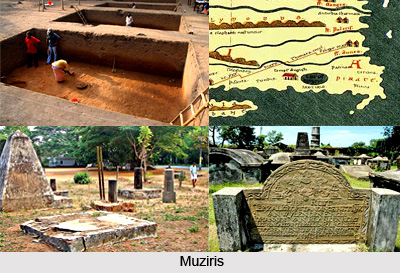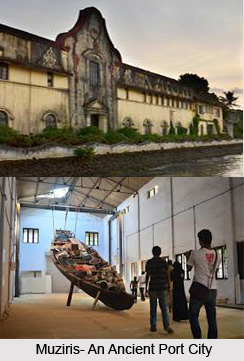 A jumble of stone and brick walls, vines and trees, and a cave surrounded by thorny vegetation - a perfect location for shooting a film on archaeology, is actually a very old port. Believed to be the most ancient port on the Kerala coast, Muziris is also said to have served as the landing harbor for ancient Roman traders in South India. The site is supposed to be close to the spot where the mighty river Periyar joins the Arabian Sea.
A jumble of stone and brick walls, vines and trees, and a cave surrounded by thorny vegetation - a perfect location for shooting a film on archaeology, is actually a very old port. Believed to be the most ancient port on the Kerala coast, Muziris is also said to have served as the landing harbor for ancient Roman traders in South India. The site is supposed to be close to the spot where the mighty river Periyar joins the Arabian Sea.
Muziris is, possibly, located close to the modern town of Kodungallur or Cranganore. The place where the river Periyar joins the aggressive and frenzied sea is now locally called Azhicode Mukku, - Azhicode is the name of the adjoining village while mukku means `corner` or `end` in Malayalam. `Muciri` means `cleft lip`, and the coastline does resemble one, especially the aerial view. The place is studded with a long row of Chinese fishing nets. The nets dip into the water as the fisherman returns after many hours to haul in the catch.
An ancient papyrus (150 A.D.) discovered at Vienna, some years ago, documents the shipment of nard, ivory and textiles from the port of Muziris to the Roman port of Alexandria in North Africa.Hwever, archaeological excavations in the Azhicode Mukku - Cranganore area have, surprisingly, not revealed substantial evidence for the Roman trade, most of the finds being of the 8th century A.D. or later.

It is said that, in 52 A.D., Apostle St. Thomas first landed in India at Muziris, planted the cross and preached Christianity. A few years later, around 69 A.D., the Jews arrived here. The Tabula Peutingeriana or Peutingericm Tables, a 4th century A.D. map, mentions a temple for the Roman emperor Augustus at Muziris. But no trace of this temple exists on date.
Presently, the Azhicode Mukku area is known for its St. Thomas Memorial - a lovely building pillared and domed, housing a bone relic of St Thomas. The remnant, from the right arm of the Apostle, displayed in a heavily ornamented box, has a long and interesting history behind it is well-known that the martyrdom of St. Thomas took place in Chennai around 72 A.D. and he was buried here. Years later, bone relics from his tomb were taken to Europe. However, a bone relic is still preserved in the San Thome Basilica in Chennai. The bone relic in the Azhicode Mukku Memorial was brought here by a devotee from Europe in the year 1953 - some thousand nine hundred years after the Apostle first landed on Indian soil.
Muziris is also known for its fort built by the Portuguese in the early 16th century. The fort is called the St. Thomas Fort in memory of the Apostle. The fort was extensively damaged by Tipu Sultan, the ruler of Mysore, in 1790.Devout Hindus flock to this area to see the massive Siva Temple at Tiruvanchikulam. The temple with its woodwork decoration and large courtyards is a fine example of the Kerala style of temple architecture. According to tradition, the temple was founded by the famous saint Sundaramurti Nayanar and his friend Cheraman Perumal.
Not too far from the temple, around 2km from Kodungallur town, is the Cheraman Juma Masjid, believed to be one of the oldest mosques in India. It was built in 629 A.D. It is said that the mosque has been named after the Hindu saint Cheraman Perumal because it was founded by some of his followers who later converted to Islam. This is the first mosque in India and the second in the world where Juma prayers (Friday prayers) were started.
Another renowned monument in the area is the Kurumba Bhagavati temple celebrating the glory of Kannagi, the heroine of the Tamil epic Silappadikaram that was written when South India had brisk trade relations with Rome. Senguttuvan, the ancient Kerala ruler, worshipped Kannagi as the Goddess of Chastity.



















